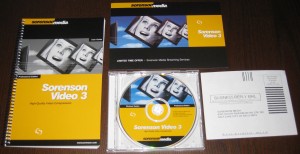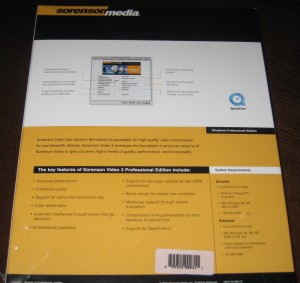On a recent dumpster dive, I procured a complete, never-been-opened copy of Sorenson Video 3 Professional Edition Compressor for Windows. And because I’m me, I thought it would be interesting to document it here:

Not opened until now, anyway:

I chuckled at the thought that I might open the user manual and find the complete data stream format listed therein. As expected, the guide offers a broad overview of video compression concepts (lossy vs. lossless, inter/intraframes, that kind of thing) and goes on to describe general guidelines for compressing different types of data. Then there is the feature reference. There are standard features and professional features (the latter includes things like bidirectional prediction, masking, and watermarking).
I was hoping to figure out how to encode some video with this software. But I think I need full Quicktime Pro in order to do that. If you’re interested, here’s the user manual in PDF format: Sorenson Video 3 User Guide (626 Kbytes). Here’s an interesting claim from the chapter on audio compression:
Most movies are made up of two parts, video and audio. Historically, the video portion of a digital movie was so large that the audio was only a minor piece of the puzzle. However, with Sorenson Video’s excellent compression capabilities it is possible to create a file where audio is the largest portion.
I know it’s possible to do that, but is it really recommended? I’m sure I have some samples in my vast repository where this is the case but it still doesn’t strike me as optimal for network delivery.
